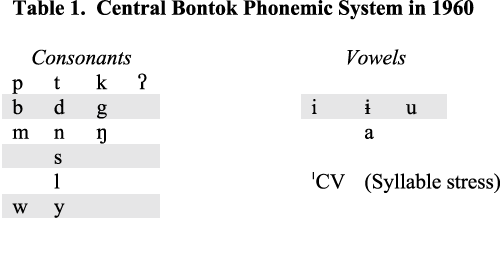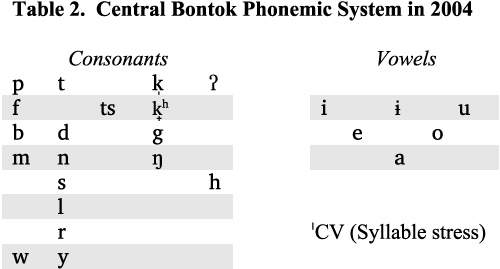Various orthographies, or spelling systems, have been used to write the
Bontok language since the first wordlists and dictionaries appeared in
the early part of this century. The orthography that has been adopted to
represent
Khinina-ang words and example sentences in this
dictionary is a systematized version of the one that is currently used
by educated native speakers, as well as in publications such as the
Bontoc translation of the New Testament and literacy materials prepared
by members of the Summer Institute of Linguistics and others. This
writing system is referred to here as the
local orthography.
Three other orthographic representations are also used. Following each
head word given in the local orthography, the form is also shown in
phonetic
orthography, in
phonemic orthography, and in
a
general
orthography.
Local Orthography. The
Khinin-ang
Bontok spelling system uses the following letters:
a, b, ch, d,
e, f, g, h, i, k, kh, l, m, n, ng, o, p, r, s, t, w, and
y. The
letter
h (apart from its occurrence in the digraphs
ch and
kh) occurs in only a few, onomatopoetic words. A hyphen (
-)
also forms a part of the spelling system. It represents a glottal stop
(a break between two sounds), when it occurs after a consonant, as in
fab-a
'tooth', or between two vowels, as in
á-ew 'shadow'. A
hyphen is also used to join the separate parts of a compound or an
idiom, as in
fab-alin-si-fílig 'a kind of small tree,
literally: mountain
fab-ali'.
Some words can be distinguished only by the position of the stressed
vowel in the word, and so stressed vowels that occur in certain
syllables (open, penultimate syllables, and which also carry extra
length) are marked with an acute accent, otherwise it is not written,
e.g.,
kháyang 'crow', and
khayang 'a kind of
spear'. Stress marks are not usually written in other publications. A
major difference between the spelling used here and that commonly used
is that the letter
u will not be found in native
Khinina-ang
words. There is no need to distinguish between the letters
u and
o, in order to efficiently spell such words. Some people also use
sh in some words that are spelled here only with an
s. For
an explanation, see Reid (
2006).
Phonetic Orthography. This is a
broad phonetic representation of
Khinina-ang words given in
standard International Phonetic Association (IPA) symbols and enclosed
in square brackets, for linguists interested in using the dictionary for
studies of phonetic phenomena in this language. From this orthography it
will be noted, for example, that the digraph
kh is an aspirated,
front velar stop [k̟ʰ], in contrast with a regular
k,
which is an unaspirated, backed velar stop [k̩], an unusual
contrast in Philippine languages. Similarly, the letter
r
represents a retroflexed rhotic [ɹ], similar to the
r-sound
in some American and English dialects. It is not flapped or trilled, as
in most other Philippine languages. Glottal stop occurs in
Khinina-ang
at the beginning of words that otherwise would begin with a vowel, but
it is not represented in these positions in the local orthography.
Otherwise, as noted above, glottal stop is represented by a hyphen. In
addition to marking a single glottal stop between two vowels, as in
á-ew
[ʔáː.ʔəw] 'shadow', hyphen also
represents a geminated glottal stop, e.g.,
ka-or
[k̩áʔ.ʔʊr] 'rooster'. The vowel written
as
e in the local orthography represents a central vowel which
varies from a high, unrounded [ɨ] to a schwa [ə] or a front
epsilon [ɛ] before velar consonants. A colon [ː] marks
vowels that are long. These are typically primary stressed vowels in
open, penultimate syllables, and a period indicates a syllable boundary.
Phonemic Orthography. This system
is useful for linguists who are interested in using the dictionary as a
source for comparative language data, either for cross-Philippine
language studies, or for reconstructing older forms of Philippine
languages. The phonemic transcription of head words in the dictionary
appear in slant brackets /bábʔa/ 'tooth' or
/gáyaŋ/ 'crow'. The phonemic analysis upon which this
system is based was completed nearly fifty years ago, using standard
American structuralist methods of checking for minimal pairs and
establishing distributional statements for allophonic variants, see Reid
(
1963). At
that time, the language had four vowels and fourteen consonants, as
shown in Table 1. This is the system that is reflected in the phonemic
transcriptions in this dictionary.

In the language spoken today, however, because of borrowed words from
English, Ilokano and other languages, many of the allophonic variants of
these phonemes have lost their conditioning factors, and are recognized
and represented as distinct sounds in the language, as shown in Table 2.
For details, see Reid (
2005)
 Generic Orthography
Generic Orthography. This spelling
system is useful for speakers of other Philippine languages, such as
Ilokano or Tagalog, who wish to use this dictionary to compare the way
Bontok words relate to words in their own languages. This orthography
was first proposed in "An Alphabet for the Bontok Language," Mimeograph,
Summer Institute of Linguistics, Philippines, 1968, and was accepted by
the Institute of National Language as the official Bontok orthography
about the same year. It was also used in the original Bontok dictionary
upon which this dictionary is based (Reid
1976).
It was based on the phonemes of the language at that time and its
purpose was to represent only the phonemes, or significant sound units
in the language, in ways which are consistent with commonly accepted
practices in many other Philippine languages. It did not represent the
phonetic variants of these sounds because these tend to obscure the
similarities between Bontok words and those of other languages, and
because of the considerable variety of variants used in the different
Bontoc communities. Thus,
f and
v do not occur, because
even though these sounds frequently occur in
Khinina-ang and
other Central Bontok dialects, they were variants of the /b/ phoneme.
Similarly
ch, and
j, which were variants of /d/, and
kh
which was a variant of /g/ was not used in the general othography.
Furthermore,
r was not used, since that sound was a variant of
the /l/ phoneme.